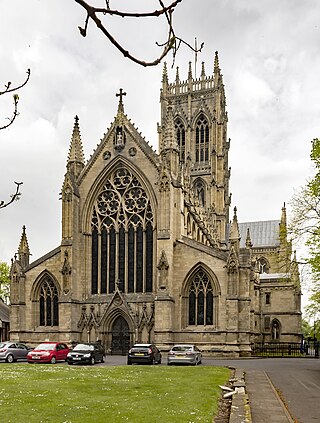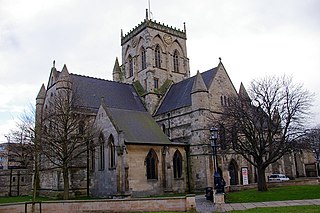
St Botolph's Church is the Anglican parish church of Boston, Lincolnshire, England. It has been referred to as "Boston Stump" since it was constructed. Its tower is 266 feet 9 inches (81.31 m) tall, and was long used as a landmark for the Boston fishermen; on a clear day it can be seen from Norfolk. The church is a Grade I listed building.

The pipe organ is a musical instrument that produces sound by driving pressurised air through the organ pipes selected from a keyboard. Because each pipe produces a single pitch, the pipes are provided in sets called ranks, each of which has a common timbre, volume, and construction throughout the keyboard compass. Most organs have many ranks of pipes of differing pitch, timbre, and volume that the player can employ singly or in combination through the use of controls called stops.

An organ stop is a component of a pipe organ that admits pressurized air to a set of organ pipes. Its name comes from the fact that stops can be used selectively by the organist; each can be "on", or "off".

The Metropolitan Cathedral Church of Saint Andrew or Glasgow Metropolitan Cathedral is a Latin Catholic cathedral in the city centre of Glasgow, Scotland. It is the mother church of the Archdiocese of Glasgow. The cathedral, which was designed in 1814 by James Gillespie Graham in the Neo-Gothic style, lies on the north bank of the River Clyde in Clyde Street. St Andrew's Cathedral is the seat of the Archbishop of Glasgow, currently William Nolan. It is dedicated to the patron saint of Scotland, Saint Andrew.

A pedalboard is a keyboard played with the feet that is usually used to produce the low-pitched bass line of a piece of music. A pedalboard has long, narrow lever-style keys laid out in the same semitone scalar pattern as a manual keyboard, with longer keys for C, D, E, F, G, A, and B, and shorter, raised keys for C♯, D♯, F♯, G♯ and A♯. Training in pedal technique is part of standard organ pedagogy in church music and art music.

An organ pipe is a sound-producing element of the pipe organ that resonates at a specific pitch when pressurized air is driven through it. Each pipe is tuned to a note of the musical scale. A set of organ pipes of similar timbre comprising the complete scale is known as a rank; one or more ranks constitutes a stop.

Doncaster Minster, formally the Minster and Parish Church of St George, is the Anglican minster church of Doncaster, South Yorkshire, England. It is a grade I listed building and was designed by architect designer George Gilbert Scott. The church was built in 1854–1858 to replace an earlier building destroyed by fire. It is an active place of worship and has a Schulze organ, a ring of eight bells, and a celebrated clock by Dent. The church is one of two parish churches to have minster status in South Yorkshire. The other is the minster church of Rotherham.
Gedackt is the name of a family of stops in pipe organ building. They are one of the most common types of organ flue pipe. The name stems from the Middle High German word gedact, meaning "capped" or "covered".

St Mary Moorfields is a Roman Catholic church in Eldon Street near Moorgate, on a site previously known as Moorfields. It is the only Catholic church in the City of London. Prior to a 1994 boundary change, the church was in the Borough of Hackney, such that there were no Catholic churches in the City.

Christ Church, Bray is in the Church of Ireland parish of Bray, County Wicklow located on Church Road on a rise, previously known as the Rock of Bray, behind Bray Town Hall. The church was built in 1863 in a Gothic Revival style.

Grimsby Minster is a minster and parish church located in Grimsby, North East Lincolnshire, England. Dedicated to St James, the church belongs to the Church of England and is within the Diocese of Lincoln.

St Boniface Church, Bonchurch is a parish church in the Church of England located in Bonchurch, Isle of Wight.

St Peter and St Paul is a church in the town of Bromley, Borough of Bromley, in south east London. Known familiarly as Bromley Parish Church, it is not far from Bromley High Street and approximately halfway between Bromley North and Bromley South railway stations. The church is part of the Diocese of Rochester within the Church of England. Largely destroyed by bombing during the Second World War, St Peter and St Paul was rebuilt in the 1950s. It has been Grade II* listed since 1955.
St Andrew's Church, Lincoln was a parish church on Canwick Road in Lincoln in the Church of England between 1877 and 1968.

All Saints Church, Cheltenham, is a Grade I listed parish church in the Church of England in Cheltenham.
The Brindley organ of St Mary's Church, Tickhill, South Yorkshire, England is a Victorian pipe organ influenced by the German organ building tradition.

St Mary's Church is the Church of England parish church of Haddenham, Buckinghamshire It is a Grade I listed building.

Casavant Frères Ltée. Opus 1841 is a pipe organ built by the famous Casavant Frères of Saint-Hyacinthe, Quebec. The organ was first completed in 1911 as Casavant Brothers - Opus 452 for St. Andrew's Presbyterian Church at 40 Bentinck Street, Sydney, Nova Scotia, Canada. St. Andrew's later became St. Andrew's United Church and is now the Highland Arts Theatre.

All Saints' Church, Bradbourne is a Grade I listed parish church in the Church of England in Bradbourne, Derbyshire.

St Martin and St Meriadoc's Church, Camborne is a Grade I listed parish church in the Church of England in Camborne, Cornwall.

















